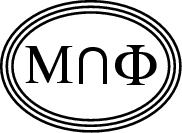
Back to
OP page
Combined
List
List by
Contributors
|
Why is the Hall Conductance Quantized?
Abstract
Formulate the theory of the Integer Quantum Hall
effect, which explains the quantization of the Hall conductance, so that
it applies also for interacting electrons in the thermodynamic
limit.
 Solved by M.B. Hastings and
S. Michalakis. Solved by M.B. Hastings and
S. Michalakis.
The problem's analysis was aided by advances which were made in the joint works by A. Giuliani, V. Mastropietro and M. Porta, and by S. Bachmann, W. de Roeck and M. Fraas.
See J. Avron's summary for a more complete account.
|
The question as it was originally posed:
The Integer Quantum Hall effect, first observed by K. von Klitzing, is
used to determine the fine structure constant with precision that is
comparable to the precision one gets from atomic physics. It is also used
as a practical and fundamental way to define the Ohm.
It is
instructive to look at the
experimental data. The
graph that looks like a straicase function has remarkably flat plateaus.
The ordinates of the plateaus correspond to integer integer multiple of
the quantum unit of conductance, and can be measured very precisely.
An intriguing aspect of this phenomenon is that a precision measurement of
fundamental constants is carried on a system that is only poorly
characterized: Little is actually known about the microscopic details of
the system, which is artificially fabricated, and whose precise
composition and shape are not known with a precision that is anywhere
comparable with the precision that comes out of the experiment.
There are two related but somewhat distinct theoretical frameworks that
attempt to answer this question. The problem we pose has to do with their
mutual relation, and the extent to which they give a satisfactory
answer.
One framework identifies the Hall conductance with a
topological invariant: The first Chern number of a certain bundle
associated with the ground state of the quantum Hamiltonian. This
framework applies to a rather general class of quantum Schrodinger
Hamiltonians, including multiparticle ones. It has two principal
drawbacks. The first is that it requires an interesting topological
structure: It applies in cases where there is a Brillouin zone, and
in cases where configuration space is multiply connected. The
multiple connectivity can be motivated, to some extent, by the
experimental setup if one includes the leads that connect to the two
dimensional electron gas in the system. This makes the Hall conductance a
property of the system and not just of the two dimensional electron gas.
The second drawback is that the Chern number is identified with a certain
average of the Hall conductance. In some cases this average comes for
free, but in general it does not.
A second theoretical framework
identifies the Hall conductance with a Fredholm index of a certain
operator. This framework is known to apply to non interacting
electrons in two dimensions where the Fredholm operator is constructed
from the one particle Schrodinger Hamiltonian of the system. This
framework applies to a particularly popular model of the Integer quantum
Hall effect: non interacting electrons in two dimensions and with random
potential.
Some models, like non interacting electrons in homogenous
magnetic field in two dimensions, and its generalization to a periodic
potential can be analyzed either framework, and the results agree. In
these cases the Hall conductance can be interpreted either as a Chern
number or as an Index.
The two frameworks are complementary: Chern
allows for electron interaction while Fredholm does not, Chern assumes an
interesting topology while Fredholm does not and requires that
configuration space be two dimensional; Chern comes with an
averaging while Fredholm does not.
The Chern framework would be a
satisfactory theory if one could take the thermodynamic limit and remove
the averaging. Progress in this direction has been made by Thouless and
Niu who described (implicit) conditions under which this is the case. The
Fredholm framework would be a satisfactory theory of the integer quantum
Hall effect if one could remove the restriction of non interacting
electrons.
References:
-
M. Aizenman and G. M. Graf,
"Localization
bounds for an electron gas",
J. Phys. A. 31, 6783, 1998.
(PDF file)
-
J.E. Avron, "Adiabatic
QuantumTransport", (Les Houches Proceedings), E. Akkermans, G.
Montambaux and J.L. Pichard eds., North Holland (1995).
(http://physics.technion.ac.il/~avron/B3.ps.gz)
- J.E. Avron and R. Seiler,
"Quantization of the Hall conductance for general multiparticle
Schrodinger operators", Phys. Rev. Lett. 54 (1985) 259-262.
- J.E. Avron, R. Seiler and B. Simon, "
Charge Deficiency, ChargeTransport and Comparison
of Dimensions", Comm. Math. Phys. 159, 399-422,
(1994).
(http://xxx.lanl.gov/abs/physics/9803014)
- J. Bellissard A. van Elst and H. Shultz-Baldes, "The Non
commutative Geometry of the Quantum Hall effect", J. Math. Phys.
35, 5373, (1994).
- J. Frohlich, "Mathematical Aspects of the Quantum Hall
effect",
Proc. of the first ECM, Paris 1992, Progress in Math.
(Birkhauser, Basel 1994).
- Q. Niu and D.J. Thouless ,
"Quantum Hall effect with realistic boundary conditions",
Phys. Rev. B35, 2188 (1987).
- Q. Niu and D.J. Thouless "Quantum Hall effect with
realistic boundary conditions", Phys. Rev. B
35, 2188 (1987).
- M. Stone, Quantum Hall effect , (World
Scientific, 1992).
-
D.J. Thouless,
"Topological quantum numbers in non relativistic physics",
(World Scientific, Singapore 1998).
-
D.J. Thouless, M. Kohmoto, M.P. Nightingale and M.den Nijs, Phys. Rev.
Lett. 49, 405 (1982).
Mail comments to:

 Solved by M.B. Hastings and
S. Michalakis.
Solved by M.B. Hastings and
S. Michalakis.